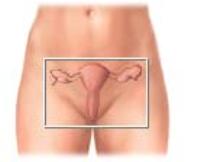Dark Brown Vaginal Discharge
It is normal if dark brown vaginal discharge occurs:-
- some time around your menstrual cycle.
- during ovulation.
- in the early stages of pregnancy.
- after a normal or Caesarean birth.
- around peri-menopause and menopause.
- when you are using IUD as birth control
Vaginal discharge that are light or dark brownish in such circumstances shouldn't be a cause for concern.
Menstruation and Dark Brown Vaginal Discharge
Brown discharge occurs when the cells of the vagina slough off at the end of the menstrual cycle (a day or two after it ends). This is a healthy and normal process.
Shedding this blood which is actually remnants of old uterine cells is our body’s way of clearing the reproductive system in preparation for our next period.
When blood mixes with vaginal fluid it appears as dark brown vaginal discharge.
For young girls it is normal for them to have a light brown discharge at the beginning of their period.
Some women may experience dark brown vaginal discharge before their menstrual cycle. Again these are old endometrial or uterine cells that the uterus failed to shed during the previous menstruation.
Ovulation
 Diagram of the uterus and vagina
Diagram of the uterus and vaginaOvulation could also be a reason for brown vaginal spotting. Normally you ovulate 10-16 days after the first day of your last period. This is when one of your ovaries release an egg for fertilization.
Ovulation occurs when your estrogen level is high and it drops when the the egg is released. The decrease in estrogen level can cause some bleeding . By the time the blood is expelled from the body it is several days old.
Old blood with lack of oxygen appears as dark brown discharge from the vagina.
Pregnancy
After an egg is fertilized it implants itself on the lining of the uterus to grow. As the lining is rich in blood, bleeding occurs when the uterine lining is disturbed during the implantation. This implantation bleeding appears as brown to bloody vaginal spotting. It does not happen in every pregnancy or in every woman.
Dark brown blood can be a signal for the onset of a miscarriage. It is best to extra conscious and consult your doctor.
Childbirth
After giving birth, heavy bleeding continues for four to six weeks. The heavy flow tapers to a light discharge and turns brown towards the end. You don’t need to worry too much as long as there are no foul smell or large clots. Such an occurrence is considered normal for most women.
Caesarean Birth
I had brown vagina discharge that lasted about 4 weeks after undergoing a C-section. A doctor’s examination indicates that nothing is wrong. He explained that it is shedding of old blood as most probably blood is not completely soaked up from the uterus during the operation.
Perimenopause And Menopause
Just before menopause, your body's hormone level becomes erratic. Peri-menopause can cause a light brown, pink or yellow discharge. It is heavy and uncomfortable for some women.
A lot of women who are nearing menopause may have dark brown discharge instead of a normal menstrual flow.
Insertion of IUD (Intra Uterine Device)
Brownish vaginal discharge may occur during the first few weeks of the insertion of the IUD. This is due to the reaction of the lining of the uterus (endometrium) to the device. It should not be a cause for concern, but if there is pelvic pain and/or fever, consult your doctor immediately.
Abnormal Brown Discharge
See a doctor if brownish vaginal discharge is prolonged and there is weight loss, pelvic pain or fever.
It could be indications of a serious illness such as cervical cancer or vaginal infection. It could also be STDs e.g. chlamydia and gonorrhea.
Cervical Cancer
According to the National Cancer Institute, cervical cancer can cause a wide variety of symptoms or no symptoms at all.
Symptoms, when present could include prolong vaginal discharge that range from watery, pale, pink, brown or bloody. Sexual intercourse can increase the bleeding and pain in the pelvic region. Other signs are loss of appetite, weight loss, fatigue, back pain and leg pain.
Chlamydia
Chlamydia is known as the “silent” disease because most women do not have signs of this STIs.
Women who do have symptoms have a yellowish to brown discharge, vaginal burning during urination, painful intercourse, fever, lower abdominal pain and bleeding between menstrual cycle.
Gonorrhea
Also known as the “clap” gonorrhea can affect multiple sites in the body but it occurs most commonly in the genital area.
Symptoms include brown and foul smelling vaginal discharge, burning sensation during urination, vaginal bleeding between periods and abdominal and pelvic pain.
Medical Checkup
See a gynecologist immediately if the brownish vaginal discharge comes with the above mentioned symptoms.
Whether it turned out to be serious or not, early detection could save your life as it stops the development of further complications.
Back to top- Home
- Vaginal White Discharge
- Dark Brown Vaginal Discharge
Like This Page?


Facebook Comments
Thanks for visiting. Have your say on what you just read? Leave a comment in the box below!